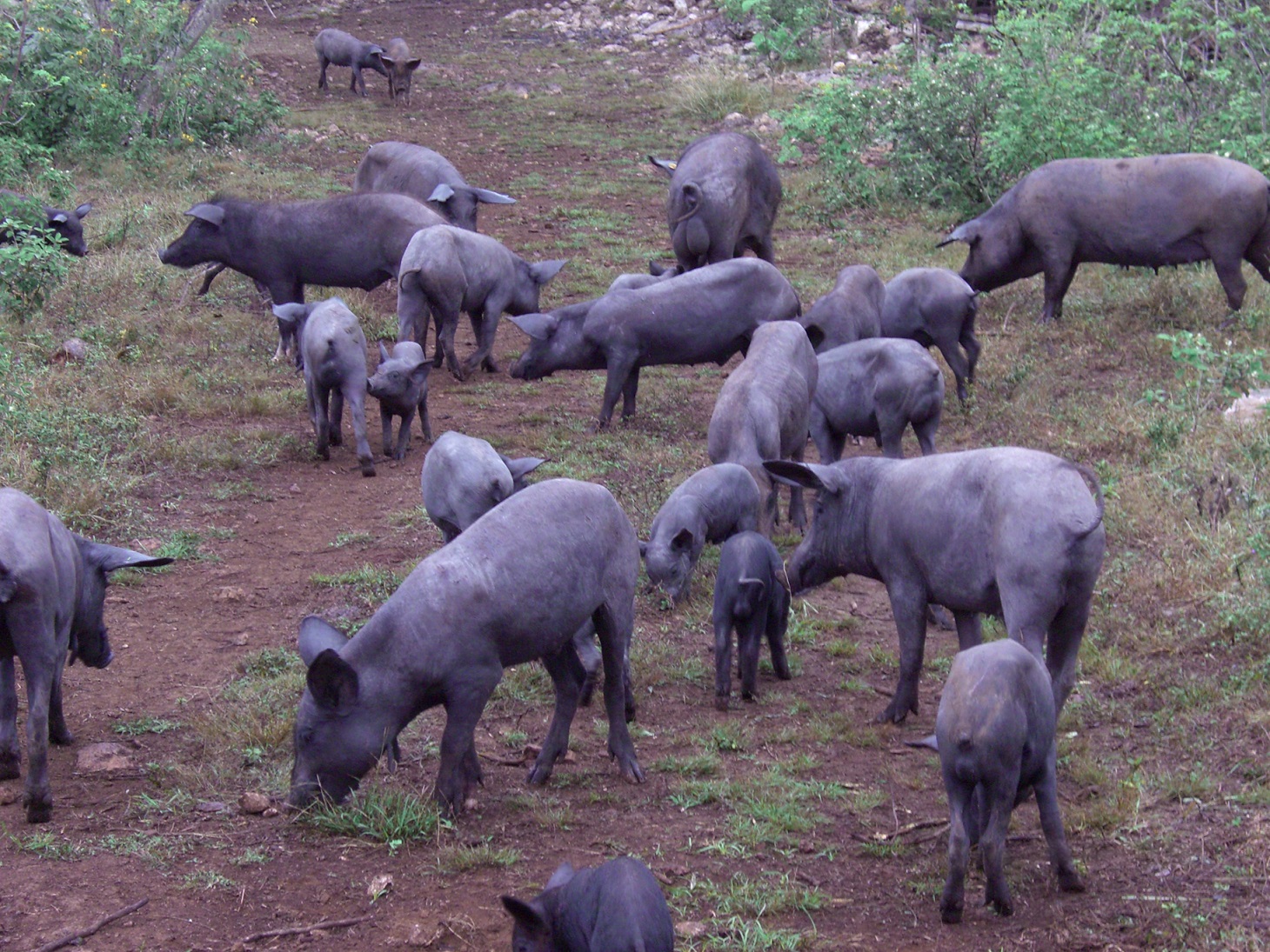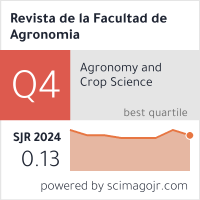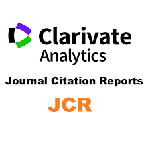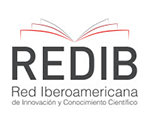Phylogenetic relationships of Yucatan hairless pig with Asian and European breeds by mitochondrial DNA D-loop
Abstract
In Mexico native pig genotypes exist whose populations face serious threats to survival. One of them is the Yucatan hairless pig (YUCMEX), for which limited information is available regarding its current conservation status. This study aimed to determine the phylogenetic relationship of YUCMEX with Iberian, wild pigs (WB), European, Asian, and commercial pigs using the mtDNA D-loop region. A total of 31 YUCMEX sequences and 77 mitochondrial haplotypes from GenBank were analyzed, aligned to reference sequence AJ002189. The study fragment, trimmed between positions 15435 and 15977, resulted in 543 base pairs. Genetic distances were calculated to compare YUCMEX with the other pig groups. Phylogenetic trees were constructed using the Neighbor-Joining method with Kimura's two-parameter distance and 1000 bootstrap replicates. Additionally, a principal component analysis (PCA) was performed based on evolutionary distances. Among the 108 sequences analyzed, 41 variable sites and 44 haplotypes were identified. YUCMEX individuals grouped into four haplogroups (HA, HB, HC, HD), showing lower D-loop diversity and genetic distance from the Duroc breed. European and Asian haplotypes formed seven phylogenetic groups, clearly separating both regions. The YUCMEX haplogroups clustered into three lineages close to WB from Portugal and Spain but were distinct from Asian pigs and Eastern European WB haplotypes. These findings confirm the European—specifically Iberian—origin of the Yucatan hairless pig.
Downloads
References
Alves, P. C., Pinheiro, I., Godinho, R., Vicente, J., Gortáazar, C., & Scandura, M. (2010). Genetic diversity of wild boar populations and domestic pig breeds (Sus scrofa) in South-western Europe. Biological Journal of the Linnean Society, 101(4), 797-822. https://doi.org/10.1111/j.1095-8312.2010.01530.x
Banayo, J.B., Manese, K.L.V., & Salces, A.J. (2023). Phylogeny and Genetic Diversity of Philippine Native Pigs (Sus scrofa) as Revealed by Mitochondrial DNA Analysis. Biochemical Genetics, 61, 1401–1417. https://doi.org/10.1007/s10528-022-10318-0
Burgos-Paz W., Souza, C.A., Megens, H.J., Ramayo-Caldas, Y., Melo, M., Lemús Flores, C., Caal, E., Soto, H. W., Martínez, R., Álvarez, L. A., Aguirre, L., Iñiguez, V., Revidatti, M. A., Martínez López, O. R., Llambi, S., Esteve Codina, A., Rodríguez, M. C., Crooijmans, R. P. M. A., Groenen, M. A. M., & Pérez-Enciso, M. (2013). Porcine colonization of the Americas: a 60k SNP story. Heredity, 110(4), 321-330. https://doi.org/10.1038/hdy.2012.109
Giuffra, E., Kijas, J.M., Amarger, V., Carlborg, O., Jeon, J.T., & Andersson, L. (2000). The origin of the domestic pig: Independent domestication and subsequent introgression. Genetics, 154(4),1785–91. https://doi.org/10.1093/genetics/154.4.1785
Hernández, A.A., García-Munguía, C.A., García-Munguía, A.M., Ortiz-Ortiz, J.R., Sierra-Vásquez, A.C., & Morales-Flores, S. (2020). Sistema de producción del cerdo pelón mexicano en la Península de Yucatán. Nova Scientia, 12(24), 1-22. https://doi.org/10.21640/ns.v12i24.2234
Ishihara S., Arakawa A., Ba N.V., Dinh N.C., Ninh P.H., Okamura, T., Dang Nguyen, T. Q., Kikuchi, K., Pham, L. D., & Taniguchi, M. (2023). Population structure of Vietnamese pigs using mitochondrial DNA. Animal Science Journal, 94(1), e13875. https://doi.org/10.1111/asj.13875
Jones, G.F. (1998) Genetic Aspects of Domestication, Common Breeds and Their Origin. In: Rothschild, M.F. & Ruvinsky, A. (Eds). The Genetics of the Pig. CAB International, Wallingford, 17-50.
Laxmivandana, R., Vashi, Y., Kalita, D., Banik, S., Sahoo, N.R., & Naskar S. (2022). Genetic diversity in mitochondrial DNA D-loop region of indigenous pig breeds of India. Journal of Genetic,101, 5. https://doi.org/10.1007/s12041-021-01353-8
Lemus-Flores, C., Alonso-Morales, R., Toledo-Alvarado, H., Sansor-Nah, R., Burgos-Paz, W., & Dzib Cauich, D. (2020). Genetic diversity and population structure of Yucatan black hairless pig using SNP50K chip. Abanico Veterinario, 10, 1-12. https://doi.org/10.21929/abavet2020.10
Lemus-Flores, C., Prado, J., Bernal, R.V., Segura-Correa, J.C., & Sansor-Nah, R. (2023). Genetic relationships of the Yucatan black hairless pig with Iberian breeds using single nucleotide polymorphism. Brazilian Journal of Veterinary Research and Animal Science, 60, e195697. https://doi.org/10.11606/issn.1678-4456.bjvras.2023.195697
Markov, N.I., Ranyuk, M.N., Babaev, E.A., Seryodkin, I.V., Senchik, A.V. Bykova, E. A., Esipov, A. V., Nurtazin, S. T., Pavlova, O. S., & Matrosova, V. A, (2022). Introduced, Mixed, and Peripheral: Conservation of Mitochondrial-DNA Lineages in the Wild Boar (Sus scrofa L.) Population in the Urals. Diversity, 14(11), 916. https://doi.org/10.3390/d14110916
Miller, S.A., Dykes, D., & Polesky, H.F. (1989). A simple procedure for extracting DNA from human nucleated cells. Nucleic Acids Research, 16(3),1216. https://doi.org/10.1093/nar/16.3.1215
Minitab, LLC. (2021). Minitab 15 Statistical Software. State College, PA: Minitab, Inc. Available from: www.minitab.com.
Niedziałkowska, M., Tarnowska, E., Ligmanowska, J., Jędrzejewska, B., Podgórski, T., Radziszewska, A., Ratajczyk, I., Kusza, S., Bunevich, A. N., Danila, G., Shkvyria, M., Grzybowski, T., & Woźniak, M. (2021). Clear phylogeographic pattern and genetic structure of wild boar Sus scrofa population in Central and Eastern Europe. Scientific Reports, 11(1), 9680. https://doi.org/10.1038/s41598-021-88991-1
Ogata, N. (2019). 1519: Hernán Cortés y la llegada del Cerdo a la diversificación productiva Mesoamericana. Diversidad Biológica y Cultural Trópico Americano, Universidad Veracruzana. https://tropico-americano.uv.mx/cerdo-pelon-mexicano/
Ortega-S, J. A., Delgado-Acevedo, J., Villarreal-González, J. G., Borroto-Páez, R., & Tamez-González, R. (2019). Wild Pigs in Mexico and the Caribbean. Invasive Wild Pigs in North America, Edit. CRC Press, 1a edition, p. 423-438. https://doi.org/10.1201/b22014-18
Perrier, X., Flori, A., & Bonnot, F. (2003). Genetic diversity of cultivated tropical plants. Data analysis methods. By Perla Hamon, P. 1a. Edit., Enfield, Science Publishers. Montpellier. p 43 - 76. https://doi.org/10.1201/9781482280043
Ramírez, O., Burgos-Paz, W., Casas, E., Ballester, M., Bianco, E., Olalde, I. Santpere, G., Novella, V., Gut, M., Lalueza-Fox, C., Saña, M., & Pérez-Enciso, M. (2015). Genome data from a sixteenth century pig illuminate modern breed relationships. Heredity 114, 175–184. https://doi.org/10.1038/hdy.2014.81
Ramos-Canché, M. E., Magaña-Magaña, M. A., Aguilar-Urquizo, E., Pech-Zapata, A., Piñeiro-Vázquez, A. T., Toledo-López, V.M., & Sanginés-García, J.R. et al. (2020). Óptimos económicos en la cría del cerdo pelón mexicano: propuesta de integración para cadena productiva. Ecosistemas y Recursos Agropecuarios, 7(1), e2302. https://doi.org/10.19136/era.a7nl.2302
Saitou, N., & Nei, M. (1987). The Neighbor-joining method: a new method for reconstructing hylogenetic trees. Molecular Biology and Evolution, 4, 406–425. http://doi.org/10.1093/oxfordjournals.molbev.a040454
Secretaría de Agricultura y Desarrollo Rural. (1998). NOM-051-ZOO-1995. Trato humanitario en la movilización de animales. Diario Oficial de la Federación. Vigente desde el 24 de marzo de 1998.http://publico.senasica.gob.mx/?doc=531
Secretaría de Agricultura y Desarrollo Rural. (2001). NOM-062-ZOO-1999. Especificaciones técnicas para la producción, cuidado y uso de los animales de laboratorio. Diario Oficial de la Federación. Vigente desde el 23 de agosto de 2001. http://publico.senasica.gob.mx/?doc=743
Tamura, K., & Kumar, S. (2002). Evolutionary distance estimation under heterogeneous substitution pattern among lineages. Molecular Biology and Evolution, 19(10), 1727–1736. https://doi.org/10.1093/oxfordjournals.molbev.a003995
Tamura, K., Stecher, G., & Kumar, S. (2021). MEGA 11: Molecular Evolutionary Genetics Analysis Version 11. Molecular Biology and Evolution, 38, 7, 3022–3027. https://doi.org/10.1093/molbev/msab120.
van Asch, B., Pereira, F., Santos, L.S., Carneiro, J., Santos, N., & Amorim, A. (2012). Mitochondrial lineages reveal intense gene flow between Iberian wild boars and South Iberian pig breed. Animal Genetics, 43, 35–41. https://doi.org/10.1111/j.1365-2052.2011.02222.x
Vergara, A.M.C., Martínez, A.M., Bermejo, J.V.D., Macri, M., Nájera, P.R.A., Duchi, N.A.D., &. Vargas, P.A.T. (2021). A Matrilineal Study on the Origin and Genetic Relations of the Ecuadorian Pillareño Creole Pig Population through D-Loop Mitochondrial DNA Analysis. Animals, 11, 3322. https://doi.org/10.3390/ani11113322
Wu, G.S., Yao, Y.G., Qu, K.X., Ding, Z.L., Li, H., Palanichamy, M.G., Duan, Z.Y., Li, N., Chen, Y.S., &. Zhang, Y.P. (2007). Population phylogenomic analysis of mitochondrial DNA in wild boars and domestic pigs revealed multiple domestication events in East Asia. Genome Biology, 8, R245. https://doi.org/10.1186/gb-2007-8-11-r245
Zhang, J., Jiao, T., & Zhao, S. (2016). Genetic diversity in the mitochondrial DNA D-loop region of global swine (Sus scrofa) populations. Biochemical and Biophysical Research Communications, 473(4), 814-820. https://doi.org/10.1016/j.bbrc.2016.03.125

Copyright (c) 2025 Clemente Lemus Flores, Gilberto Lemus Avalos, Job Oswaldo Bugarín Prado, Rogelio Alonso Morales, Raúl Ulloa Arvizu, José Candelario Segura Correa, Miguel Ángel Ayala Valdovinos, Raúl Sansor Nah

This work is licensed under a Creative Commons Attribution-NonCommercial-ShareAlike 4.0 International License.


















